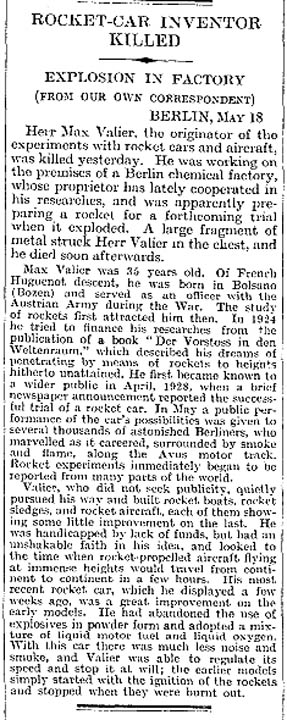May 17 1930
From The Space Library
German rocket experimenter Max Valier, the originator of the rocket car, was killed in a factory in Berlin when a liquid fueled rocket he was preparing exploded.
His colleague and engineer Walter Riedel witnessed the accident.
After a number of previous experiments, further tests using kerosene as fuel were conducted on (Saturday), May 17, 1930. These tests were fatal to Valier. The tests were begun early that afternoon. The first two were successful; a good combustion process could be recorded. During the third test, however, jolts occurred, owing to which the traverse and the scale balance were deformed. The liquid oxygen tank had been emptied in the course of the tests. In view of the jolts that had occurred during the last burning, and as it would be quite a long time before the installation would be ready for combustion again, I proposed to Valier that he call it a day. But he was so encouraged by the successful findings that he wanted to carry on the work. So the combustion chamber was assembled again. While the exhaust nozzle worked with before had had a diameter of 28 mm, for this test a nozzle 40 mm in diameter was already to be used. At nine in the evening everything was ready. The combustion chamber was ignited and the pressure in it raised to 7 atm gauge pressure by the old, well-known procedure, by regulating the hand valves for the propellants and water. Just as the combustion chamber had attained this pressure, there was a violent explosion. I immediately closed all the propellant valves and sprang over to Valier, who collapsed. I was only just able to catch him as he fell , and laid him on the floor. While a machinist and my colleague Arthur Rudolph looked after him, I went off in search of a car. When I came back 10 minutes later , Max Valier had already died. A tiny splinter had struck him in the pulmonary artery.
The presumed cause of the explosion can be explained as follows: The emulsion of kerosene and water entered the combustion chamber through an atomizing cone. During the period of regulation of the propellants up to the maximum combustion chamber pressure, part of the emulsion burned while another part was not involved in the combustion. The part that was not involved mixed with liquid oxygen, and as the latter has a very low temperature the emulsion was able to change into a jelly-like mass in which the oxygen was enclosed. This mass was deposited on the inner wall of the combustion chamber. Just before the explosion took place, part of the layer detached from the wall and dropped into the combustion zone, so that the jelly-like mass, which, chemically, is a highly explosive mixture, immediately burnt off explosively. This tragic accident paralyzed further development for a long time - all the more since it had cost the life of one of the best and most successful of men.

